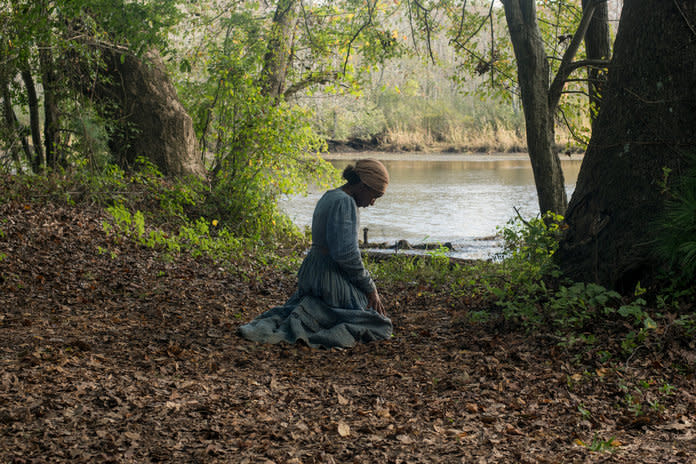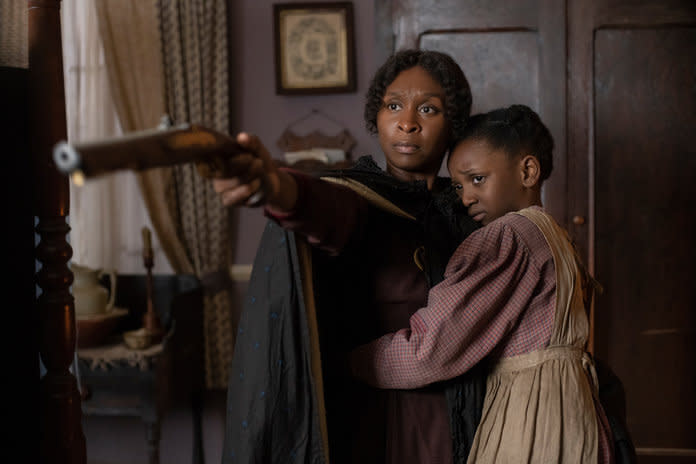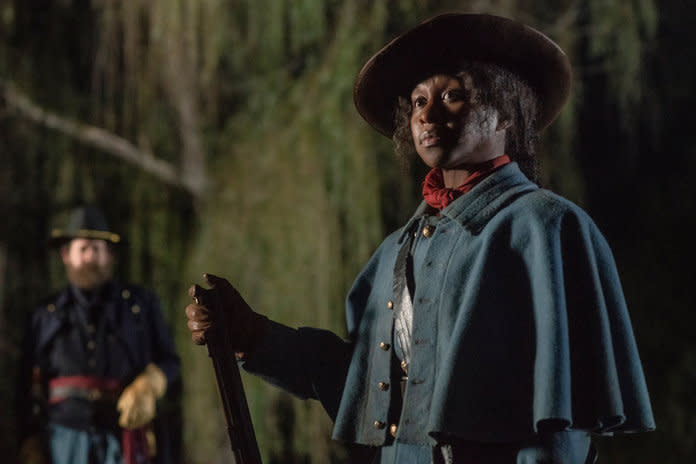How Cynthia Erivo's Costumes, Hair, and Makeup Tell Harriet Tubman's Heroic Story
It’s tough to believe that 2019 marks the first time Harriet Tubman’s story has been told on the big screen. But Harriet, in theaters now, benefits from the craftsmanship and precision of a creative team passionate to get it right. Director Kasi Lemmons, who first broke out with Eve’s Bayou in 1997, leads a celebrated cast that includes Cynthia Erivo in the title role and supporting turns from Leslie Odom Jr. and Janelle Monáe. The movie depicts Tubman’s escape from slavery and her subsequent missions to free others on the Underground Railroad.
Her character evolves dramatically — from a young married woman enslaved on a plantation, to a freedom fighter who changed the face of history and rescued more than 700 slaves in a single raid during the Civil War. It’s a drastic and heroic arc vividly reflected in the costumes and styling of Erivo’s character on screen. Harriet’s design team balanced careful attention to historical accuracy with creative vision to craft a visual interpretation of her story that could only have been made today.
“Kasi and I wanted to underscore how her role was heroic and mythic, to elevate the energy of her persona,” says costume designer Paul Tazewell, a Tony winner for Hamilton. Tazewell’s extensive research included studying daguerreotypes (an early form of photography) from the period, including depictions of plantation slavery. They not only informed practical aspects of the garments in the film, but inspired the overall look of his designs.
“My hope was for it to feel like a tinted daguerreotype,” Tazewell says, referring to grayscale photographic images from the period that were colored by hand. “I felt there was this great richness in the visual quality of sepia tone that has just a pop of color.” In early scenes that show Harriet, then known as “Minty,” among fellow slaves, it’s color that sets her apart. Tazewell designed her costume in cooler tones with a red head wrapping. “I was interested in carrying red through to the very end because I felt like it had heraldry behind it, like the idea of a superhero,” Tazewell says. Indeed, Harriet wears a richly textured jacket of that color in her final scene.

Harriet is more of a hero’s journey than a slave narrative. “We set out to make a movie that wasn’t about slavery; it’s about freedom and empowerment,” producer Debra Chase tells InStyle. Lemmons’ film focuses on Harriet’s tenacity and triumphs rather than the brutality that she fought so hard against. This creative direction informed how violence is evidenced on characters’ bodies — scars are subtle and blood is kept to a minimum. “We tried to keep a balance,” says makeup designer Angie Wells. Scars and discoloration are meant to remind viewers what the slaves have been through, Wells explains. “But we didn't want [the scars] to be so gruesome that you were taken out of the moment.”
The team did take creative license to enhance one scar in particular: Tubman suffered a temporal head injury as a child, which was believed to be the reason she experienced seizures. In the film, these moments are imagined as divine visions that help lead her to safety on numerous occasions. “You wouldn't be able to see [the scar] because of the way she wore her hair,” Wells says. Lemmons found a bust of Tubman that features a triangular indentation between the brows indicating her scar. Wells and the director decided to incorporate the visible scar into Erivo’s makeup look given that her spiritual episodes are significant in the film.
RELATED: How Renee Zellweger Transformed Into Judy Garland for the Late Star's Biopic
Once she reaches Philadelphia and claims the name Harriet Tubman, the character begins to look more refined. In addition to becoming a free woman, she’s also a young person growing up and discovering her identity. For the scenes in which Minty is enslaved, Wells applied a thin layer of foundation in a redder shade than Erivo’s skin to achieve the warm, coppery undertone of someone who works in the sun. Once Erivo becomes Harriet as we know her, Wells added subtle highlights and contouring and took the redness out of her skin. To avoid the matte look of obvious makeup, “I would often mix moisturizer or primer in with the foundations that I use to keep that sort of luminous look of skin,” Wells says.
Harriet’s hair likewise reflects her journey throughout the film. “It’s about making the hair tell the story as much as you can,” says hair and wig designer Belinda Anderson. As she’s escaping slavery, Harriet’s hair comes loose when she washes up on a riverbank (having also lost her shoes). Once she reaches north, and Monáe’s character Marie Buchanon takes her under her wing, Harriet’s hair begins to evolve, eventually reaching the middle part and chignon style in which she was often depicted. Scenes that show Marie brushing out Harriet’s hair in the bath demonstrate the kinship between them. “Particularly for women of color, caring for each other's hair is just natural, culturally,” Wells says. “It's more than just doing hair, it’s a time of comuning and showing care.”

Marie helps Harriet navigate how to present herself as a free woman, lending her a green dress for her first rescue mission back down south. “I wanted to choose a color that would tie her to the earth, to her ability to move in and out of nature,” Tazewell says, while also aiding her ability to move through society as a conceivably free woman. It’s the first of many such versatile looks that allow Harriet to continue freeing slaves without getting caught.
RELATED: The Fashion Significance of Juneteenth
“It's documented that she became a master of disguise,” Tazewell says. “She could become a chameleon and go in and out of areas without being noticed.” There are no visual representations of Tubman in such disguises for obvious reasons, so Tazewell took liberties with combining period-appropriate pieces that Tubman may have been able to get her hands on. Many of these looks include conventionally masculine silhouettes. It’s a creative direction echoed in Erivo’s performance, and one that lends the film a distinctly contemporary air.

“When you put a piece of clothing on that feels like it belongs to the character, it makes you carry yourself differently,” Erivo tells InStyle. From the men’s jacket and hat Harriet wears on the film’s poster to the “Blackjack” uniform associated with African-American sailors from the period, menswear in the film serves as both clever disguise and a means to show Harriet is not to be messed with. “I gravitated toward [more masculine] silhouettes when she needs to show strength, because it just wouldn't translate in the same way if it were a straightforward bodice and skirt,” Tazewell says. It’s also a question of function; as Harriet continues leading freedom expeditions, her clothes become more practical, which means less trekking through the woods in a corset and petticoats.
RELATED: How the Costume Designer from A Different World Brought '80s Magic to Mixed-ish
“The disguises worked into what she then adopted as an expression of herself and her own style,” Tazewell says of the evolution of Harriet’s look in the film. While as a free woman she may have been attuned to what was fashionable, “I wouldn’t want people to interpret that she was fashion-forward as part of the design,” Tazewell says. Rather, the heightened quality of her costumes is meant to offer insight into her interior character. “This is a new way of telling her story,” Tazewell says. “Hopefully it’s true to the energy of who that woman potentially was all around, as much as we can ever know.”
With additional reporting by Susan Hornik.

